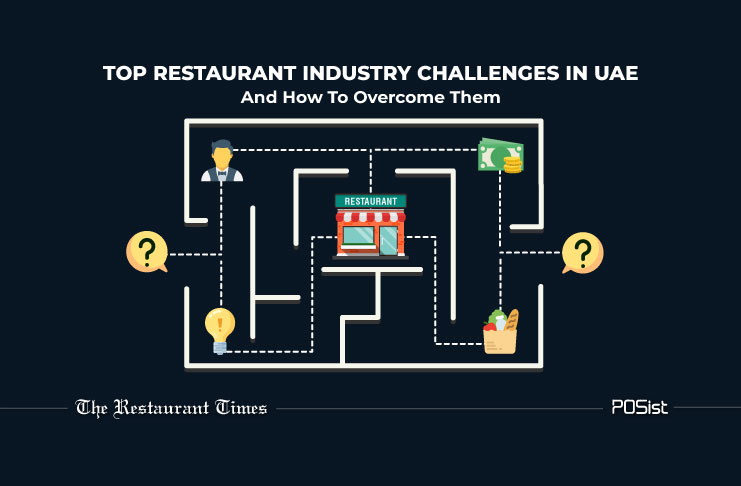UAE is not just one of the world’s most profitable marketplaces for the food sector, but it’s also one of the most cutthroat. The good news is that as the market becomes saturated, service providers are developing more complex ideas, new trends are emerging, and consumers have an abundance of options. The bad news is that the restaurant business in Dubai, Abu Dhabi, and the rest of the UAE is facing more difficulties than ever.
Regardless of your existing expertise, here is a list of the top hurdles you will encounter in the restaurant sector in the United Arab Emirates. We also go through how you might handle these challenges to open your restaurant. Here are some difficulties restaurants may encounter and solutions!
- Higher Rents
While expensive rent seems to be the rule elsewhere in the world, UAE, and particularly Dubai, suffer the most. Depending on the size and format, the typical cost to open a small, independent restaurant in Dubai ranges from AED 500,000 to AED 1.25 million. Even these numbers are based solely on restaurants with 500 square meters to 1,200 square meters of space. Furthermore, capital expenses, rent, and working capital account for 78% of the restaurant industry’s cash outflow. Therefore, the biggest and most immediate problem you will have in Dubai’s restaurant market is exorbitant rentals.How to Avoid Sky-High Rental Prices in the UAE
As for the solutions, you must first realize that there is no getting around this problem, therefore your business might as well bear the entire brunt of it. What we’re trying to say is that while you might be tempted to shop on the cheaper side of the city because Dubai has so many little towns with diverse populations, doing so will only squander your money. Money invested with the right mindset and a clear plan can be recovered.Consider your target market, restaurant format, cost of obtaining raw ingredients, and menu prices while choosing your site. Look for areas that still meet your needs. Examine the NOC and additional legal documents thoroughly. High rents are unavoidable, therefore you must account for them in your spending plan. In addition, you can cut costs in other areas of running your restaurant, balancing your budget.
- Too little business and too much competition
With the “Diversification Pan” in place, Dubai Expo 2020 approaching, and the hospitality and restaurant business occupying the central role in the plan and the associated economic changes, two things have occurred:-There is now intense competition.
The ratio of customers to restaurants has increased
The basic conclusion of these two impacts is that cannibalization makes it difficult for eateries to compete in the market. Here, cannibalization is distinct from that of rivals. Cannibalization occurs when rivalry intensifies to the point where the entire sector begins to see a general decline in customer demand.Due to its special place in the country’s shifting economic landscape, the restaurant industry in the UAE has drawn both investors and businesspeople. The outcome was straightforward—too many service providers saturated the market—as there were few actual entry barriers and increased global trade.
The second side of the same coin is that, despite a rise in visitors, the speed of new restaurants opening up shop could not keep up with it. In the end, this led to “The Problem Of Plenty”—a paradoxical scenario in which consumers had too many options since there were too many service providers, making it difficult for them to choose what to invest their money in. Due to increased rivalry, problems and difficulties in the foodservice industry keep becoming worse.
How to Win in the UAE’s Toughest Market
Let’s first simplify this problem and challenge for the restaurant industry. The phrase “The Problem of Plenty” simply refers to the fact that there are so many restaurants that, even while the number of customers generally is growing, the effect of this growth is being spread out throughout the various establishments, which reduces individual profitability.Now turn your attention to your customers. Customers are still making purchases; they are just doing them in various areas. As a result, the problem can be solved by concentrating on both acquiring new consumers and keeping existing ones. 20% of restaurant patrons account for 80% of business, and all are repeat patrons.
- Absence of a USP
The UAE restaurant markets are currently experiencing a distinct issue. Most people looking to enter the restaurant industry lack a USP because it is almost completely saturated. Consumers are bored of the sameness and low quality of the experiences and meals being offered, even when no one is overtly mimicking another. Everything has been done since the UAE is so far ahead in the restaurant business. As a result, it is challenging to develop a completely new offering, in part because of the fierce competition and in part because of the variety of customers, making it challenging to foresee what will succeed and what will fail. How To Be Different From The Competition In The UAE
Conducting thorough market research, finding out what clients want, and tracking industry trends are all feasible solutions to this problem. When a market reaches a specific maturity level, it is struck by certain trends brought on by a shift in consumer habits. Because of this, no market is ever totally steady for an extended period of time, and no industry is ever truly saturated. You will be able to identify gaps in the ostensibly tight-knit market and seize the initiative there as long as you keep an eye on the trends propelling the hospitality sector.

